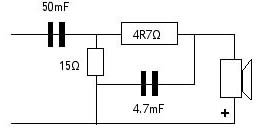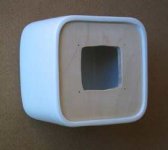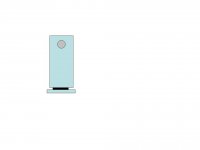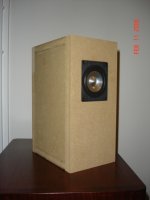I've found that the sound settles in after a while, though I'm not sure if that is my ears or the driver burning in.
The original JX53 required a compensation circuit to prevent it sounding hard and too forward. I haven't yet experimented with this but here is the HF section from the 500Hz crossover for the JX53. Ignore the 50mF cap - the other components should form a starting point for a comp network. At the moment, I haven't felt the need to experiment.
BTW, how low is the JXR6 going in the 4 litre cabinet?
The original JX53 required a compensation circuit to prevent it sounding hard and too forward. I haven't yet experimented with this but here is the HF section from the 500Hz crossover for the JX53. Ignore the 50mF cap - the other components should form a starting point for a comp network. At the moment, I haven't felt the need to experiment.
BTW, how low is the JXR6 going in the 4 litre cabinet?
Attachments
Dean thanks for the baffle step link. I often prefer placing the speakers further into my room as I feel this helps with the sound stage image and depth. I plan on doing as you suggest and round over the baffle edges with a ¾” round-over bit. I really should do this first and then reassess the performance of my design. I could also do as you suggest and not center the driver in the middle of the baffle, but this would be difficult with my current cabinet configuration (outside dimension of cabinet using ¾” MDF – 5 3/8” wide by 7 ¾” deep by 11 5/8” tall). Once I add a ¾” round over to the baffle, the remaining space is around a ¼” on each side. I could rebuild the same cabinet again and use the 7 ¾” side for the baffle as this would better accommodate an off-centered driver placement, but this would be like starting over. If I build another set of cabinets, I really want to try a 2-liter volume. Either way, I will keep the off centered driver placement in mind for future designs.
Colin you too raised a good point, and that is I really don’t have much play time on these drivers yet (plopped them into the boxes last night and then proceeded to listen for a couple of hours). After my initial audition last night I left the speakers playing pink noise and plan to do so for a day or so before I listen again. How much time do you recommend for driver “break-in”?
Colin you too raised a good point, and that is I really don’t have much play time on these drivers yet (plopped them into the boxes last night and then proceeded to listen for a couple of hours). After my initial audition last night I left the speakers playing pink noise and plan to do so for a day or so before I listen again. How much time do you recommend for driver “break-in”?
If they are out in the room, you would need some sort of baffle step compensation, and the step freq will be right in the 700-1K range (sorry, don't have formula handy).Hardman said:Over all I really like the sound of the new Jordan. It does sound a little forward and I wonder if it needs some baffle step correction or something. My cabinet is 5 3/8” wide. Any suggestions?
Also, are you using anything for bass? These 50mm drivers definitely need something for 100Hz and below, if played without bass driver it would sound unbalanced.
I'm not sure the drivers do require breaking in, it may just be a psychological effect. However, I found they sounded okay after 24 hours or so.
The roundover on the baffle will help matters. I would doubt rebuilding them to mount them off centre would be worth it. My baffles are 6 x 6" - they are equidistant horizontally, slightly offcentre vertically but only by half an inch or so.
They don't do bad considering the output rolls off below 100Hz or so (mine still have output to 80Hz). Certainly in the micro-monitor category. I've heard small two-ways which have done worse. What I really like are the tiny nuances, the sense of stopping on a dime. It's going to be fun matching them to a non-Jordan driver for the bass.
The roundover on the baffle will help matters. I would doubt rebuilding them to mount them off centre would be worth it. My baffles are 6 x 6" - they are equidistant horizontally, slightly offcentre vertically but only by half an inch or so.
They don't do bad considering the output rolls off below 100Hz or so (mine still have output to 80Hz). Certainly in the micro-monitor category. I've heard small two-ways which have done worse. What I really like are the tiny nuances, the sense of stopping on a dime. It's going to be fun matching them to a non-Jordan driver for the bass.
Attachments
Continuing with my Jordan design....
I still dont have the JXR6 HD drivers yet, there has been a delay with my local supplier. In the meantime I have been doing more planning to complete the design.
Interesting in WinISD there is only a marginal difference between a 2.6l cabinet (ideal Q of 0.71) and a 4l cabinet, in fact the -3db points dont change at all, its still about 120Hz. I assume that the spiderless design of the JXR6 is not taken into account by WinISD? The real differences between varying enclosure sizes is the slope of the low end response curve (Q). As I'll be filtering below 100-150Hz the extra volume size is not important.
The active equaliser that I use is setup to lower the total system Q to 0.5 using the tangband 871 driver, to match the subwoofer Q of 0.5, and as the tangband enclosure has a Q of 0.75, I dont need the larger enclosure to lower the enclosure Q when using the JXR6. Also the current TangBand enclosure is 6L and does has slightly worse low frequency response compared to the JXR6 at least when modelling in WinISD.
Regarding the cabinet design, I'll be making a mini version of the popular jordan wide baffle design, as attached, 400mm high, 200mm wide, 75mm deep size 2.6l, sitting on a plinth. The drivers will be rebated into the front baffle and I wont be using any felt surrounds, but the edges will have a 45 degree rebate.
I'm a little concerned with such a small enclosure and a wide back panel but not very deep that back panel reflections will be a problem with this design, especially as the reflected wave will pass through the thin Jordan cone, adding an out of phase component and possible cone distortion. As the 75mm distance to the back panel is not that large, any reflection that passes out the front will not be too much out of phase, although as its only the lower frequencies that will pass through through this should not matter much.
Is this really a problem with such a small driver, thin cone and this cabinet design? Is there a cabinet stuffing or lining that would work well with such a small depth?
Regards,
Dean
I still dont have the JXR6 HD drivers yet, there has been a delay with my local supplier. In the meantime I have been doing more planning to complete the design.
Interesting in WinISD there is only a marginal difference between a 2.6l cabinet (ideal Q of 0.71) and a 4l cabinet, in fact the -3db points dont change at all, its still about 120Hz. I assume that the spiderless design of the JXR6 is not taken into account by WinISD? The real differences between varying enclosure sizes is the slope of the low end response curve (Q). As I'll be filtering below 100-150Hz the extra volume size is not important.
The active equaliser that I use is setup to lower the total system Q to 0.5 using the tangband 871 driver, to match the subwoofer Q of 0.5, and as the tangband enclosure has a Q of 0.75, I dont need the larger enclosure to lower the enclosure Q when using the JXR6. Also the current TangBand enclosure is 6L and does has slightly worse low frequency response compared to the JXR6 at least when modelling in WinISD.
Regarding the cabinet design, I'll be making a mini version of the popular jordan wide baffle design, as attached, 400mm high, 200mm wide, 75mm deep size 2.6l, sitting on a plinth. The drivers will be rebated into the front baffle and I wont be using any felt surrounds, but the edges will have a 45 degree rebate.
I'm a little concerned with such a small enclosure and a wide back panel but not very deep that back panel reflections will be a problem with this design, especially as the reflected wave will pass through the thin Jordan cone, adding an out of phase component and possible cone distortion. As the 75mm distance to the back panel is not that large, any reflection that passes out the front will not be too much out of phase, although as its only the lower frequencies that will pass through through this should not matter much.
Is this really a problem with such a small driver, thin cone and this cabinet design? Is there a cabinet stuffing or lining that would work well with such a small depth?
Regards,
Dean
Attachments
Originally posted by Dumbass
If they are out in the room, you would need some sort of baffle step compensation, and the step freq will be right in the 700-1K range (sorry, don't have formula handy).
I used the formula for BSC found in the link Dean provide and if I did the math correctly… it looks like the 848 Hz for a baffle of 5 3/8” wide. But how does the round-over come into play? A ¾” round-over on each baffle edge will reduce the flat surface by 1.5”. If I were to add a correction circuit, I assume the original width of 5 3/8” is no longer valid once a round-over is deployed?
Originally posted by Colin
It's going to be fun matching them to a non-Jordan driver for the bass.
Very interested in what driver you pick.
Attachments
I've found that these formulae are more a guide than anything else. Differences in driver specs, components and most importantly the room environment will vary actual response from theory.
I'd suggest using the formula as a rule of thumb, assuming the rounded edges reduces the baffle width by 1/2 the size of the round diameter. The rounding doesnt so much affect the baffle step frequency but it smoothes the baffle step curve.
Grab a sound level meter and a CD with test tones and take in room measurements to tweak the last 20%. You may be shocked to find greater than +- 10db variation with in room measurements especially in the bass response.....
Regards,
Dean
I'd suggest using the formula as a rule of thumb, assuming the rounded edges reduces the baffle width by 1/2 the size of the round diameter. The rounding doesnt so much affect the baffle step frequency but it smoothes the baffle step curve.
Grab a sound level meter and a CD with test tones and take in room measurements to tweak the last 20%. You may be shocked to find greater than +- 10db variation with in room measurements especially in the bass response.....
Regards,
Dean
Remember that the baffle step frequency is just an approximation, because the center-to-edge distance varies throughout the edge of the baffle. So baffle step loss starts at the frequency associated with the nearest edge(s), but is actually distributed over a range of frequencies.Hardman said:I used the formula for BSC found in the link Dean provide and if I did the math correctly… it looks like the 848 Hz for a baffle of 5 3/8” wide. But how does the round-over come into play? A ¾” round-over on each baffle edge will reduce the flat surface by 1.5”. If I were to add a correction circuit, I assume the original width of 5 3/8” is no longer valid once a round-over is deployed?
Using 848 Hz should be fine. Remember, that is also going to be approximate because inductors only come in certain values.
The value you will want to fine-tune is R_parallel, that adjusts the amount (dB) of attenuation.
The baffle-step dropoff is already gradual because of the rectangular baffle. I personally don't see any reason to round off the edges, unless for visuals.deandob said:The rounding doesnt so much affect the baffle step frequency but it smoothes the baffle step curve.
Baffle Step Transition Roundover
As others have said the baffle step transition occurs at several hundred Hz so the edge roundover has little effect on BSC.
On the other hand the baffle edge roundover will impact sound diffraction at several thousand Hz so a smooth roundover would reduce high frequency hash associated with the edge. In reality a roundover of just 0.75" or so isn't enough to seriously reduce diffraction.
Jim
As others have said the baffle step transition occurs at several hundred Hz so the edge roundover has little effect on BSC.
On the other hand the baffle edge roundover will impact sound diffraction at several thousand Hz so a smooth roundover would reduce high frequency hash associated with the edge. In reality a roundover of just 0.75" or so isn't enough to seriously reduce diffraction.
Jim
You think this is an issue with a wide-range cone driver?Jim Griffin said:On the other hand the baffle edge roundover will impact sound diffraction at several thousand Hz so a smooth roundover would reduce high frequency hash associated with the edge. In reality a roundover of just 0.75" or so isn't enough to seriously reduce diffraction.
I know these issues are important with wide-dispersion tweeters, would think it less important with the directionality of a full-ranger.
Felt would work - the BBC used it for years in their enclosure designs.
Regarding bass for the JXR6, I'm currently using a JX92. Eventually I'll use a couple of Jordan bass units I have. (I have a partition wall which is ideal for an infinite baffle arrangement, with about 800 litres behind it per driver!)
I'll be interested to see what anyone else comes up with.
Regarding bass for the JXR6, I'm currently using a JX92. Eventually I'll use a couple of Jordan bass units I have. (I have a partition wall which is ideal for an infinite baffle arrangement, with about 800 litres behind it per driver!)
I'll be interested to see what anyone else comes up with.
A little off topic but not really because I was really interested in the JX-6. Like I was anticipating from the JX-6 FR, people say this speaker is a little forward and needs BSC to get a balanced sound. Also the struggle to get much bass under 100 hz. Similar problems to the Tang-Band W4-1320sb I bought and failed with.
While I have not bought them yet, the 5" Fostex FX-120 is $197.40/pair, no rising response curve, and bass to 70 hz in a 7 litre vented cabinet, or 110 hz (-5db 90 hz) in a 3.5 litre sealed cabinet. All with no BSC, multiple line arrays etc.
The Jordan looks really good for a 2" driver good to 100 hz; but in the end, can you really beat the laws of physics?
While I have not bought them yet, the 5" Fostex FX-120 is $197.40/pair, no rising response curve, and bass to 70 hz in a 7 litre vented cabinet, or 110 hz (-5db 90 hz) in a 3.5 litre sealed cabinet. All with no BSC, multiple line arrays etc.
The Jordan looks really good for a 2" driver good to 100 hz; but in the end, can you really beat the laws of physics?
Nope, it's all tradeoff. For true single-driver system, JXR6 won't do . . . but I don't see it being marketed that way.chuck55 said:n the end, can you really beat the laws of physics?
I'd like to see someone build a system in the vein of this passive 1st order xover system with Jordan drivers:
http://www.t-linespeakers.org/projects/rune/index.html
This was done with the JX53, presumably one could cross over somewhat lower with the new driver.
Depending on power handling and slope, I'd have thought you could cross to the JXR6 anywhere from 100-200Hz. Mine are using the rolloff from their sealed box (2nd order) to do the job. I'd anticipate it might clean up a little or handle more power if I put in a proper x/over. However Thor, on the fullrange forum, reported that adding a passive x/over to his JX92 sealed system messed up the sound and he preferred to let the box do the job.
I think Jordan market the JXR6 as a wideband driver rather than fullrange. It isn't really intended to do much below 100Hz. (Although I presume the linear array would go a bit lower.)
I think Jordan market the JXR6 as a wideband driver rather than fullrange. It isn't really intended to do much below 100Hz. (Although I presume the linear array would go a bit lower.)
- Status
- This old topic is closed. If you want to reopen this topic, contact a moderator using the "Report Post" button.
- Home
- Loudspeakers
- Full Range
- Jordan JXR6 HD Designs



